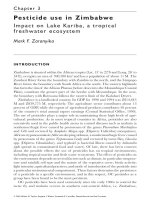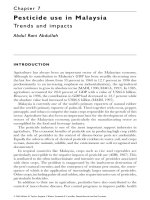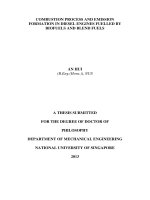Excellence in business communication 12e by vthill and brovee chapter 10
Bạn đang xem bản rút gọn của tài liệu. Xem và tải ngay bản đầy đủ của tài liệu tại đây (1.11 MB, 36 trang )
Copyright © 2017 Pearson Education, Inc.
Excellence in
in
Excellence
Business Communication
Communication
Business
Chapter 10
Writing Persuasive Messages
Copyright © 2017 Pearson Education, Inc.
Learning Objectives
1.
2.
(1 of 2)
Apply the three-step writing process to persuasive messages.
Describe an effective strategy for developing persuasive
business messages, and identify the three most common
categories of persuasive business messages.
Copyright © 2017 Pearson Education, Inc.
Chapter 10 - 3
Learning Objectives
3.
(2 of 2)
Describe an effective strategy for developing marketing and
sales messages, and explain how to modify your approach
when writing promotional messages for social media.
4.
Identify steps you can take to avoid ethical lapses in
marketing and sales messages.
Copyright © 2017 Pearson Education, Inc.
Chapter 10 - 4
Using the
the Three-Step
Three-Step Process
Process for
for Persuasive
Persuasive
Using
Messages
Messages
(LO 1) Apply the three-step writing process to persuasive
messages.
Copyright © 2017 Pearson Education, Inc.
Chapter 10 - 5
Step 1: Planning
Persuasive Messages
Analyze the Situation
Select the Medium
Copyright © 2017 Pearson Education, Inc.
Gather the Information
Organize the Message
Chapter 10 - 6
Analyzing the Situation
Gauging Audience Desires and Interests
Demographic Information
Psychographic Information
Audience’s Level of Motivation
Copyright © 2017 Pearson Education, Inc.
Chapter 10 - 7
Gathering Information
Persuasive
Persuasive and
and Compelling
Compelling
Business Messages
Copyright © 2017 Pearson Education, Inc.
Marketing
Marketing
Messages
Messages
Sales Messages
Chapter 10 - 8
Selecting the Right Combination of Medium
and Channel
Nature of Persuasive Messages
Range of Consumer Attitudes
Variety of Communication Media
Copyright © 2017 Pearson Education, Inc.
Chapter 10 - 9
Organizing Your Information
The Direct or the Indirect Approach?
What Is Your Relationship with
What Is the Extent of Your Power,
the Audience?
Authority, or Expertise?
Copyright © 2017 Pearson Education, Inc.
Chapter 10 - 10
Step 2: Writing
Persuasive Messages
Use Positive and Polite
Respect Cultural Differences
Language
Understand Culture
Establish Your Credibility
in Organizations
Copyright © 2017 Pearson Education, Inc.
Chapter 10 - 11
Building Your Credibility
Providing Objective Evidence
Identifying Your Source Materials
Focusing on the Audience’s Interests
Establishing Common Ground
Copyright © 2017 Pearson Education, Inc.
Chapter 10 - 12
Step 3: Completing
Persuasive Messages
Evaluate Your Content
Proofread Your Message
Copyright © 2017 Pearson Education, Inc.
Produce Your Message
Distribute Your Message
Chapter 10 - 13
Developing Persuasive
Persuasive
Developing
Business Messages
Messages
Business
(LO 2) Describe an effective strategy for developing persuasive
business messages, and identify the three most common
categories of persuasive business messages.
Copyright © 2017 Pearson Education, Inc.
Chapter 10 - 14
Framing Your Arguments
(the AIDA Model)
Attention
Catch the Audience’s Attention
Interest
Provide Additional Details or Benefits
Desire
Explain Benefits; Address Objections
Action
Suggest Specific Audience Action
Copyright © 2017 Pearson Education, Inc.
Chapter 10 - 15
Balancing Emotional and Logical
Appeals
(1
(1 of
of 2)
2)
Emotional Appeals
Logical Appeals
Feelings
Analogy
Emotions
Induction
Sympathies
Deduction
Copyright © 2017 Pearson Education, Inc.
Chapter 10 - 16
Balancing Emotional and Logical
Appeals
Copyright © 2017 Pearson Education, Inc.
(2
(2 of
of 2)
2)
Chapter 10 - 17
Avoiding Faulty Logic
•
•
•
•
•
•
Hasty generalizations
Circular reasoning
Attacking an opponent
Oversimplifying a complex issue
Mistaken cause-effect assumptions
Faulty analogies
Copyright © 2017 Pearson Education, Inc.
Chapter 10 - 18
Reinforcing Your Position
Believable
Powerful
Evidence
Words
Metaphors
Audience
and Stories
Benefits
Copyright © 2017 Pearson Education, Inc.
Chapter 10 - 19
Anticipating Objections
CounterNegative
NegativeElements
Elements
Counter
Focuson
onPositive
PositiveCommunication
Communication
Focus
PresentAll
AllSides
Sidesof
ofthe
theSituation
Situation
Present
Copyright © 2017 Pearson Education, Inc.
Chapter 10 - 20
Avoiding Common Mistakes in Persuasive
Communication
Common Mistakes
Using a Hard Sell Approach
Being Resistant to Compromise
Relying Solely on Great Arguments
Using a “One-Shot” Approach
Copyright © 2017 Pearson Education, Inc.
Chapter 10 - 21
Common Categories of Persuasive
Messages
Requests for Action
Presentation of Ideas
Claims and Requests for Adjustment
Copyright © 2017 Pearson Education, Inc.
Chapter 10 - 22
Persuasive Requests
for Action
Direct
Direct Approach
Approach to
to
Indirect
Indirect Approach
Approach to
to
Persuasion
Persuasion
Persuasion
Persuasion
Anticipated Request
Unanticipated Request
Copyright © 2017 Pearson Education, Inc.
Chapter 10 - 23
Persuasive Presentation
of Ideas
Consider a New Idea
Changing
Attitudes or
Beliefs About
Reexamine Opinions
a Topic
Reconsider Ways of Thinking
Copyright © 2017 Pearson Education, Inc.
Chapter 10 - 24
Persuasive Claims and Requests for
Adjustment
Review the Facts in a Positive Tone
Outline the Problem and Its Status
Give Reasons for Granting the Claim
Close on a Respectful Note
Copyright © 2017 Pearson Education, Inc.
Chapter 10 - 25









